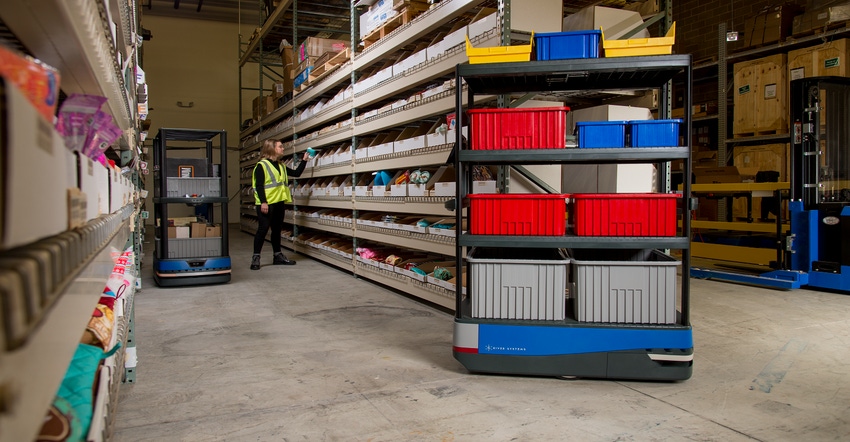Demand for automated guided vehicles skyrockets as applications for these mobile robots expand.
October 4, 2022

Automated guided vehicles (AGVs) have come a long way in contributing to a new wave in robotics automation. Together with cobots, AGVs have taken robots out of the cage and made them useful in a wide range of automation, from warehouse and manufacturing to health care and retail.
Mobile vehicles are delivering new levels of efficiency in a wide range of automation settings. “Robots have been synonymous with driving manufacturing productivity for decades,” said Eric Foellmer, VP of marketing for Boston Dynamics in a statement. “But while fixed automation systems have become mainstays on the plant floor, we are just entering the beginning stages of a new breed of robotic technology whose impact promises to be every bit as profound,”
Nonmanufacturing industries – from retail and healthcare to agriculture and package delivery – are catching on to the capabilities of mobile robots. This is driving new demand for the machines. According to a report published by Next Move Strategy Consulting, the global AGV market generated $4.02 billion in 2021 and is estimated to reach $8.66 billion by 2030, a CAGR growth of 8.9% from 2022 to 2030. While some of this growth is a result of the increased need for automation during the pandemic, the growth trend was strong even before the shutdown.
The reason for the growth, according to Next Move, is the increase in demand for material handling through automated solutions in manufacturing, and the rise in implementation of automation solutions in healthcare, automotive, e-commerce, and food industries. While the high cost of initial investment and lack of skilled labor have restrained the market growth, These issues will become less of a factor as competition drives down prices and the workforce grows more accustomed to the technology.
The AGV Versus the AMR
Terminology in the mobile robot industry is fluid, and marketing professionals haven’t helped with clarity. Terms are used loosely. Some view automated guided vehicles as an umbrella term that includes autonomous mobile robots (AMRs). Others distinguish these acronyms as describing two different navigation systems.
In navigation, the AGV travels along a fixed route, while the AMR navigates without a fixed route, much like autonomous cars navigate from point A to point B without specific paths. Both vehicles are designed to avoid obstacle collisions. The AGV must stay on its route; when it encounters an obstacle, it comes to a stop since it can’t navigate off its route. The AMR is designed to go around obstacles if possible.
The Uses of AGVs
6 River Systems, a company that creates AMRs for warehouse fulfillment, noted that AGVs are programmed for tasks that are typically handled by forklifts, conveyor systems, or manual carts, repetitively moving large volumes of material. In manufacturing and warehousing, AGVs transport raw materials such as metal, plastic, rubber, or paper. AGVs can transport raw materials from receiving to the warehouse or deliver materials directly to production lines. AGVs can consistently and reliably deliver raw materials without human intervention, ensuring that production lines can continue without interruption.
In addition to transporting raw materials, AGVs are used in work-in-process applications and with finished goods to support production or manufacturing lines. In work-in-process applications, AGVs move materials or parts from the warehouse to production lines or from one workstation to another, providing repetitive and efficient movement of materials throughout the manufacturing process.
In the retail setting, AGVs can roam the aisles inspecting shelves for stock outages, sending data back to control for replenishment. In hospitals, AGVs can deliver medical and food to patient rooms, and even navigate elevators. In agriculture, AGVs can automate field tasks, from plating to harvesting.
AGV Navigation
AGV navigation typically uses one or more of the following mechanisms:
Magnetic guide tape — some AGVs have magnetic sensors and follow a track using magnetic tape.
Wired navigation — some AGVs follow wire paths embedded into the facility floor. The wire transmits a signal that AGVs detect via an antenna or sensor.
Laser target navigation — with this method, reflective tape is mounted on objects such as walls, fixed machines, and poles. AGVs are equipped with a laser transmitter and receiver. The lasers reflect off of the tape within the line of sight and are used to calculate the object’s angle and distance from the AGV.
Inertial (gyroscopic) navigation — some AGVs are controlled by a computer system with the aid of transponders embedded into the facility floor to verify that the AGV is on the proper course.
Vision guidance — No modification is required to the infrastructure for vision-guided AGVs. Cameras record the features along the route, and AGVs rely on these recorded features to navigate.
Geoguidance — Like vision-guided AGVs, no infrastructure modifications are required for AGVs that use geoguidance. Geoguided AGVs recognize objects in their environment to establish their location in real-time to navigate throughout the facility.
LiDAR — LiDAR (Light Detection and Ranging) is a sophisticated navigation technology utilizing sensors that transmit laser pulses to measure the distance between the robot and objects in its environment. This data is compiled to create a 360-degree map of the environment, allowing robots to navigate the facility and avoid obstacles without the need for any additional infrastructure.
About the Author(s)
You May Also Like





